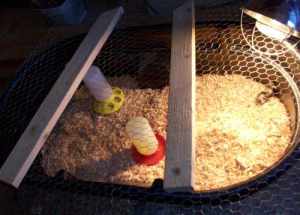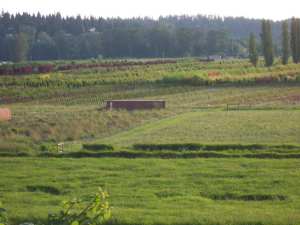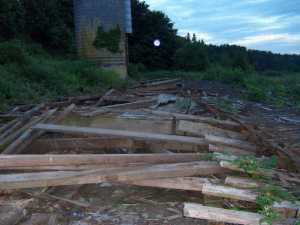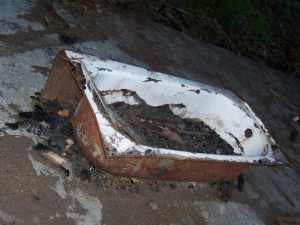Here is an update on my ducks. First, the bad news. My black Runner duck hen died. 🙁 I was trying to separate them into different pens before dark, she split off on her own, got scared and hid in the blackberry vines. When it gets dark, they won’t come out and put themselves away in their pens like they do before dusk.
I feared that if I left her all night something would get her, so I risked using the dogs to help me find her. Well, Maggie found her, and bit her quick in the neck, and she died instantly. So, lesson learned, letting the dogs hunt for singleton ducks in the dark is a bad idea (it worked once before though!). I’m sad to lose her, she was a nice looking duck and a good layer. So, of my last summer’s investment in purebed show ducks, both Runners are gone, but both Magpies have persisted.
The good news is that I have nine fertile eggs in the incubator due today-2 Magpies and 7 half-breeds. Two have already hatched, and I’m hoping the rest will come through OK. The first two seemed to have a much easier time than the last batch, so I think my improved setup and extra humidity is helping.
Here is the broken-open egg of duck #1, you can see he made a textbook exit, and a day early to boot. The next photo shows him newly hatched and tired, all flopped out on the bottom of the incubator.

This first little guy was lonely last night, it’s amazing how strong their instinct is to want to be with a group, or somebody. In desperation, he was jumping at the sides of the hatching pen to get closer to me! He kept issuing distress calls, and I worried about him experiencing that much stress all night, since his next of kin wouldn’t be arriving until the next day. So, I gave him a little stuffed animal, and that worked, he snuggled up to it and relaxed.
Here is my new hatcher setup. Last time, I used a wire dog crate, with cardboard lining the interior walls. That worked well, except that the small tray at the bottom couldn’t handle the water load of them spilling so much, and it eventually leaked on the floor (that was a mess!). So, I’ve changed to a livestock water trough with chicken wire on the top (and this is shut in a bedroom where dogs and cats can’t go!).
Here are a few more incubation details. Though I’ve now added an electric egg turner to the device, you take it out the last three days, to allow the chicks to orient themselves for hatching. So, here is what the incubator looks like with the screen floor back in, and lots of sponge pieces to evaporate and add extra humidity. I’ve also been misting the eggs daily with water.
And, here are a couple of pictures of egg candling. I found that I don’t need a fancy device, just a strong flashlight, and cupping my hand in a “C” shape between the light and the egg does the trick. First, an infertile egg: you can see the yellow yolk in there, and no blood vessels at all– this one never started growing.
This next photo shows a fertile egg on day 26- the egg is completely dark, full of duckling, except for the air pocket at the top, which has grown quite large.

This time, I wrote (in pencil) on the eggs their laying date, so I could keep track of the viability of older eggs (some were kept two weeks in my pantry before incubating). That is working well, except I see now I should write on the end of the egg opposite to the air cell, because when they crack out, they are obscuring my writing!
This time too, when I set them for their last three days, I marked all the “tops” of the eggs with an “X.” I’ve found that when the first few start to hatch, they thrash around in there and roll the other eggs around. I suspect flipping some of them a day before they hatch may mess them up, so this time, I’m trying to put them back right-side-up if I notice they’ve been disturbed.















